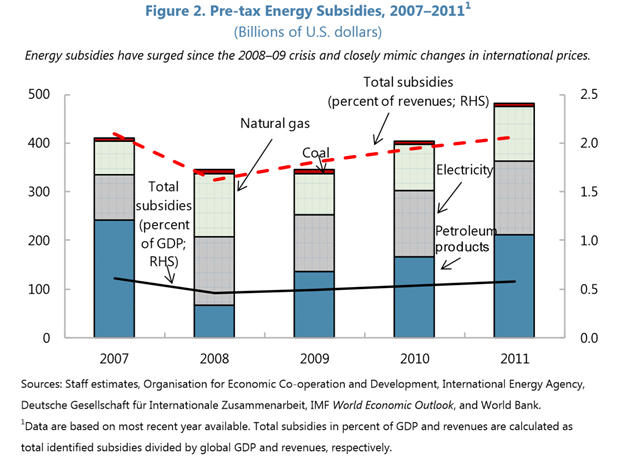Graph of the Day: Global pre-tax energy subsidies, 2007-2011
27 March 2013 (IMF) – Global pre-tax energy subsidies are significant. The subsidy estimates capture both those that are explicitly recorded in the budget and those that are implicit and off-budget. The evolution of energy subsidies closely mimics that of international energy prices (Figure 2). Although subsidies declined with the collapse of international energy prices, they have started to escalate since 2009. In 2011, global pre-tax subsidies reached $480 billion (0.7 percent of global GDP or 2 percent of total government revenues). Petroleum and electricity subsidies accounted for about 44 percent and 31 percent of the total respectively, with most of the remainder coming from natural gas. Coal subsidies are relatively small at $6½ billion. These estimates are likely to underestimate energy subsidies and should be interpreted with caution. First, data on producer subsidies are not available for all countries and all products.8 Second, consumer subsidies for liquefied petroleum gas (LPG) are not included due to lack of data. Third, fuel subsidy estimates are based on a snapshot of prices paid by firms and households at a point in time (end-of-year) or average of end-of-quarter prices when such data are available. Fourth, for electricity, natural gas, and coal, they lack full comparability across countries, since they are drawn from different sources and use different approaches. Fifth, they rely on the assumption of similar transportation and distribution margins across countries. Sixth, in light of these factors, our subsidy estimates may differ from those found in country budget documents (including those reported in the case studies supplement). Seventh, the estimates of corrective taxes are made on the basis of studies for just a few countries and a common assumption regarding how these would vary with country income levels. However, these weaknesses are outweighed by the merits of constructing a broad picture of the magnitude of energy subsidies across as many countries and products as possible.
